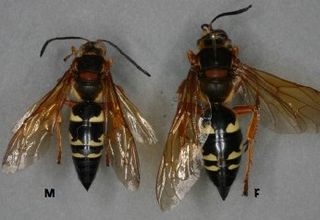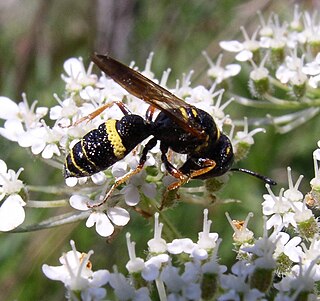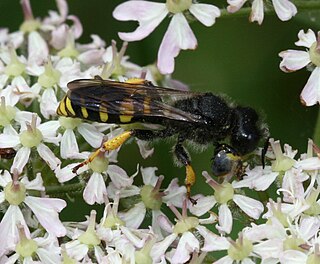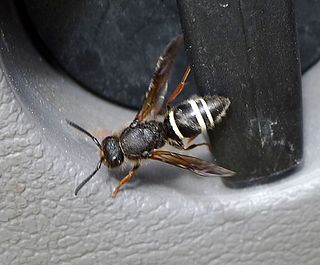
Sphecius speciosus, often simply referred to as the cicada killer or the cicada hawk, is a large digger wasp species. Cicada killers are large, solitary wasps in the family Crabronidae. The name may be applied to any species of crabronid which preys on cicadas, though in North America it is typically applied to a single species, S. speciosus. However, since there are multiple species of related wasps, it is more appropriate to call it the eastern cicada killer. This species occurs in the eastern and midwest U.S. and southwards into Mexico and Central America including Louisiana. They are so named because they hunt cicadas and provision their nests with them. In North America they are sometimes called sand hornets, although they are not hornets, which belong to the family Vespidae. Cicada killers exert a measure of natural control on cicada populations and thus may directly benefit the deciduous trees upon which their cicada prey feed.

Loam is soil composed mostly of sand, silt, and a smaller amount of clay. By weight, its mineral composition is about 40–40–20% concentration of sand-silt-clay, respectively. These proportions can vary to a degree, however, and result in different types of loam soils: sandy loam, silty loam, clay loam, sandy clay loam, silty clay loam, and loam. In the USDA textural classification triangle, the only soil that is not predominantly sand, silt, or clay is called "loam". Loam soils generally contain more nutrients, moisture, and humus than sandy soils, have better drainage and infiltration of water and air than silt and clay-rich soils, and are easier to till than clay soils. The different types of loam soils each have slightly different characteristics, with some draining liquids more efficiently than others. The soil's texture, especially its ability to retain nutrients and water are crucial. Loam soil is suitable for growing most plant varieties.

Potter wasps, the Eumeninae, are a cosmopolitan wasp group presently treated as a subfamily of Vespidae, but sometimes recognized in the past as a separate family, Eumenidae.
Soil texture is a classification instrument used both in the field and laboratory to determine soil classes based on their physical texture. Soil texture can be determined using qualitative methods such as texture by feel, and quantitative methods such as the hydrometer method. Soil texture has agricultural applications such as determining crop suitability and to predict the response of the soil to environmental and management conditions such as drought or calcium (lime) requirements. Soil texture focuses on the particles that are less than two millimeters in diameter which include sand, silt, and clay. The USDA soil taxonomy and WRB soil classification systems use 12 textural classes whereas the UK-ADAS system uses 11. These classifications are based on the percentages of sand, silt, and clay in the soil..

Philanthus triangulum, commonly known as the European beewolf, bee-killer wasp or the bee-eating philanthus, is a solitary wasp that lives in the Western Palearctic and Afrotropics. Although the adults of the species are herbivores, the species derives its name from the behavior of the inseminated females, who hunt Western honey bees. The female places several of its paralyzed prey together with an egg in a small underground chamber, to serve as food for the wasp larvae. All members of the genus Philanthus hunt various species of bees, but P. triangulum is apparently the only one that specializes in Western honey bees.

The Bembicinae comprise a large subfamily of crabronid wasps that includes over 80 genera and over 1800 species which have a worldwide distribution. They excavate nests in the soil, frequently in sandy soils, and store insects of several orders, for example Diptera, Orthoptera, Hemiptera, Lepidoptera and Odonata in the burrows. Some species are kleptoparasites of other Bembicinae. The different subgroups of Bembicinae are each quite distinctive, and rather well-defined, with clear morphological and behavioral differences between them.

Commonly known as cuckoo wasps or emerald wasps, the hymenopteran family Chrysididae is a very large cosmopolitan group of parasitoid or kleptoparasitic wasps, often highly sculptured, with brilliant metallic colors created by structural coloration. They are most diverse in desert regions of the world, as they are typically associated with solitary bee and wasp species, which are also most diverse in such areas.

Philanthus gibbosus, which is commonly referred to as a beewolf due to its predation practices, is a species of bee-hunting wasp and is the most common and widespread member of the genus in North America. P. gibbosus is of the order Hymenoptera and the genus Philanthus. It is native to the Midwestern United States and the western Appalachians. P. gibbosus are often observed to visit flowers and other plants in search of insect prey to feed their young. The prey that P. gibbosus catches is then coated in a layer of pollen and fed to the young wasps.

Exeter Chiefs are an English professional rugby union club based in Exeter, Devon. They play in Premiership Rugby, England's top division of rugby.
Episyron gallicum is a spider-eating wasp which, as its name suggests, has a distribution centred on France.

Episyron rufipes, the red-legged spider wasp, is a red and black or completely black spider-hunting wasp.

Episyron quinquenotatus, the white-trimmed black wasp, is a North American species of pompilid spider hunting wasp.

Caliadurgus fasciatellus is a species of spider wasp from the subfamily Pepsinae found from Western Europe to the Far East of Asia.

Ammophila urnaria is a species of hunting wasp in the family Sphecidae. It is a black and red insect native to the eastern United States. It feeds on nectar but catches and paralyses caterpillars to leave in underground chambers for its developing larvae to consume.

Podalonia hirsuta is a species of parasitoidal wasps in the family Sphecidae.

Stizus fasciatus is a species of sand wasps belonging to the family Crabronidae.

Crabro cribrarius, common name slender bodied digger wasp, is a species of wasps belonging to the family Crabronidae.

Argogorytes mystaceus is a species of solitary wasp in the family Crabronidae.

Ancistrocerus scoticus is a Palearctic species of potter wasp.

Cerceris rybyensis, the ornate tailed digger wasp, is a Palearctic species of solitary wasp from the family Crabronidae which specialised in hunting small to medium-sized mining bees. It is the type species of the genus Cerceris and was named as Sphex rybyensis by Carl Linnaeus in 1771.



















